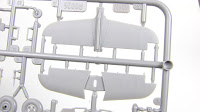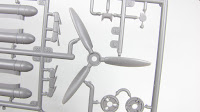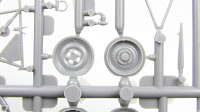1:48 Hurricane Mk IIb

New 1:48 Hurricane Mk.IIb from Arma Hobby was only a matter of time. Just a couple of months has passed from the initial release of the “C” variant and here we have it. Let’s take a closer look.
Disclaimer
The review sample was kindly provided by the manufacturer. Thanks, Arma Hobby.
Overview
This time there is not much going on in the boxart prepared by Piotr Forkasiewicz, but nevertheless the front of the 40007 set looks great.
The kit content is additionally protected by a cardboard insert, which is the standard for a larger boxes from AH.
Inside – three injection moulded sprues made of grey plastic, small transparent one, decals, masks and assembly manual.
The kit in question is based on the previously released Hurricane Mk.IIc (see review), but of course with the new wings sprue.
Grey plastic
Let's begin a more detailed inspection of the kit content with the fuselage, divided quite traditionally, lengthways into two halves.
With one exception. The underside of the tail section (with a quite nicely marked linen covering) was designed as a separate element and we get it in two variants, one of which is unused in this edition (use part 27).
But let's go back to the earlier mentioned halves and take a closer look at the considerable amount of both raised and recessed surface details, which look quite decent, to say the least. One small downside is the area around the little fairings located on either side of the engine, on the horizontal panel line behind the exhausts.
Both the rudder and the elevator were designed as a separate pieces, glued to their respective stabilisers.
Two spinners are provided for the three-blade propeller and the assembly's mounting method allows it to remain mobile.
Exhausts are another multi-variant component, with two sets available on the sprues (only those marked with 16 are to be used). Unfortunately, they don't look the best (no exhaust holes), which will probably prompt many modellers to reach for out-of-box replacements.
Let's return to the fuselage halves one last time, to take a peek at the inner surfaces of the cockpit sides, which are enhanced by a number of small equipment details (parts 32-36).
The space in between is to be filled with quite nice looking main structural elements.
The control column (17-19) and the rudder pedals (21, 22) don’t look bad either.
Since the model doesn’t include photo-etched details, the pilot's seat (25-28) can be fitted straight out of the box with decal straps only.
Prints will also enhance rather nice looking instrument panel (29) with compass (30).
The completely new wings are probably the most interesting part of the kit. Good looking too – both the upper and lower surfaces have been showered with a whole bunch of different details.
Of particular note are the rivets, featured both in raised and recessed form. This mimics the variation of such joints present on the real machine, where flush rivets were used on the surfaces with the greatest influence on the airframe's aerodynamics (e.g. wings’ leading edge), and standard mushroom-headed ones on the remaining surfaces.
The leading edge features machine guns' exit holes and cut-outs for the landing lights (parts 47 and 48 plus glazing).
The issue of the outer Brownings with their protruding nozzles was quite interestingly tackled. The correct position of the barrels (3) is achieved with an additional element (4, 5) glued into a recess inside the lower part of the wing, and a tab in the upper part.
If you are wondering what the parts 6 and 7 visible in the previous photos are for – those are plastic masks with which you can cover the landing gear bay during painting. For real.
The wing’s underside features also slots for easy installation of the oil cooler (5, 7 and unlabelled part 6) along with its housing (3, 4, 8).
Nearby are attachment points for the carburettor air intake (14-15). The tropical filter version (28, 29), also present on the sprues, won't be used this time.
Structural elements of the main landing gear bay also got a dose of varied surface details.
Raised rivets can also be found on the fairings, and the two-piece wheels are notable for the inscriptions on the tyres' sidewalls.
The latter can also be spotted on the tailwheel, the assembly of which was prepared in two versions.
The kit underwing armament consists of a pair of bombs with racks.
Additional fuel tanks are also included, but if you choose one of the set’s paint schemes, you should leave them alone.
Finally, let's take a look at a handful of minor details such as the aerial mast (58), the pitot tube (57), exhaust glare shields (59, 60), and the retractable entry footstep (50).
The last one should be only installed if the handhold behind the cockpit was left open.
Transparent plastic
The transparent sprue is filled mostly by canopy elements of a very good transparency and definitely acceptable thickness.
The windscreen is complemented by a backward-sliding part in two variants – depending on whether you want to install it in the open or closed position.
One will find here also a handful of minor details such as glass for landing lights and the rear-view mirror.
Two types of the latter provided – round one and rectangular.
Masks
The included masks, cut in the familiar and well-liked yellow adhesive paper, will help with painting the canopy.
Two versions of the stickers for the sliding part, depending on whether the open or closed option is chosen.
Decals
The markings prepared in the form of decals are a collaboration between the model manufacturer and Techmod company.
As usual this means a high quality print with not much to complain about.
Stencils and instrument panel looks nice and clear.
Seatbelts, if one like them in this form, are there too.
Manual
The booklet with step-by-step instructions on building the model is typical for AH. Clear and easy to follow assembly drawings sprinkled here and there with additional comments.
Suggested paint colours listed in a table.
Paint schemes, as usual in colour, with decal placement directions.
Usual stuff.
Markings
With included decals one can make a miniature in one of three painting options, traditionally hinted on the back of the box. To quote the manufacturer, those are.
Hurricane Mk.IIb “Hurribomber”, BE489/AE-Q “Butch the Falcon”, No. 402 Squadron RCAF, Warmwell, February 1942.
Hurricane Mk.IIb Z3171/SW-P “Hyderabad City”, No. 253 Squadron RAF, Hibaldstow, pilot F/SGT. J.C. Tate, winter 1941/42.
Hurricane Mk.IIb, Z3675/WX-B, No. 302 Squadron PAF, Church Stanton, August 1941.
Not an overwhelming selection for sure, but I’m glad that there’s a Polish option included.
Summary
Mk.IIb kit maintains the high quality level of its predecessor, with which it shares most of its sprues. Just add aftermarket seatbelts plus exhausts and you have a great starting point for building a lovely 1:48 scale Hurricane.
I like it.







































































































